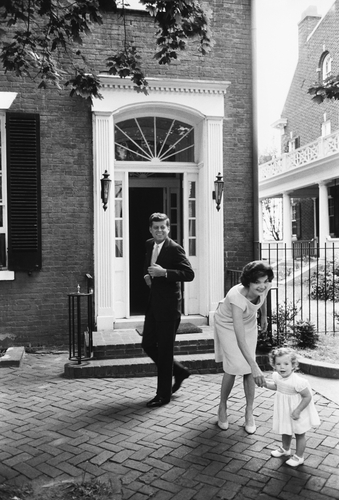BRATTLEBORO — “The most important thing for a photographer is to make your subject feel comfortable in your presence,” said David Shaw, a Dummerston-based filmmaker and photographer and co-director of the Mark Shaw Archive.
He said that trust and level of comfort was what led Jacqueline Kennedy to ask for Mark Shaw to be the photographer for a photo essay on her and her family for Life magazine in 1959.
But David Shaw said she had another reason for asking for his father to do the photo shoot.
“She knew Mark's work from the fashion magazines and that he shot the spring and fall shows in Paris every year. Jackie wanted to get the inside scoop on what the designers were doing for the coming season.”
An enduring legacy
Mark Shaw, who died in 1969, was a well-known freelance photographer in the 1950s and 1960s, but his Life photos of the Kennedys are his most famous works. An exhibition containing some of this iconic photography is on display until Jan. 3 at the The Dianich Gallery in Brattleboro.
David Shaw, who is also a photographer for The Commons, operates the Mark Shaw Archive with his wife, Juliet Cuming.
Catherine Dianach Gruver, who owns and operates the Dianach Gallery in the Hooker-Dunham Building, is a neighbor of Shaw and Cuming. David Shaw said Gruver had “asked me eight zillion times” to put together an exhibit of his father's work, but “we didn't have the time or the prints in our possession to do one.”
“As a curator and a photographer, I have always wanted to show the work,” Gruver said, “but they've often been off in other places around the world.”
This summer, serendipity intervened.
An exhibit of Mark Shaw's work in Riga, Latvia, was concluding, and David Shaw said the prints were headed back to the U.S. at about the same time that Gruver made yet another request for a proposed election season exhibit of the Kennedy photos.
This time, the timing worked out, and Gruver got access to the photos, some of which have never been displayed in galleries. David also loaned some prints from his personal collection at his home.
How he got those pictures
The Mark Shaw photos of the Kennedys have an intimacy that is rare in an age of highly-stylized celebrity photography. While the Kennedy family was masterful in its use of the media to create and burnish its image, the Shaw photos seem guileless and unguarded.
That look came from Mark Shaw's shooting style. He preferred taking pictures away from the studio, so they would look more natural.
“He was very quiet and didn't get up in people's faces,” David said. “You can see from the original negatives that he would take three or four pictures, and then move on to something else. Jack and Jackie were comfortable being around him.”
Having time and access allows a photographer to be patient and capture subjects in their natural setting, David said.
“When Life assigned him to shoot Audrey Hepburn, they gave him two weeks to do the assignment,” David said. “Now, you're lucky if you can get 15 minutes.”
Some of those Hepburn photos, taken in 1953 during the making of her first big film, “Sabrina,” are part of the Dianach exhibit. David said they help show another side of his father's work - his fashion and celebrity photography.
Capturing 'Camelot'
When Mark Shaw did his first photos of the Kennedys for Life in 1959, John F. Kennedy was a second-term U.S. senator from Massachusetts getting ready to run for the 1960 Democratic presidential nomination.
The photos of the young family in their town house in Georgetown and the Kennedy compound in Hyannis Port created the image of a young, vigorous leader, his beautiful and stylish wife, and his adorable children that stuck in voter's minds in 1960.
Mark Shaw and the Kennedys became friends after that initial shoot, and Shaw became the unofficial “family photographer.” He took the first published pictures of John F. Kennedy Jr. for his first birthday, and many more shots of “John-John” and Caroline as they grew up in the White House.
In early November 1963, Shaw was preparing a collection of these photos for a book, “The John F. Kennedys: A Family Album.” Within a couple of weeks of beginning work on the book, John F. Kennedy was assassinated in Dallas, Texas.
“The John F. Kennedys: A Family Album.” was published by Farrar, Straus in 1964, with the final image - a shot of an empty Oval Office - taken in the late afternoon of Nov. 22, 1963, the day of the president's death. The first edition was a best seller, and an expanded edition, with additional photos, was published in 2003.
“When people think of John F. Kennedy, these images keep coming up,” David said. “These pictures have been around for more than five decades, and they still have an effect on people.”
Gruver agrees.
“In these political times, I felt that the photographs were especially relevant,” she said. “They serve as a reminder of a sense of optimism and idealism that many people wish to reconnect with. I think it's such an important exhibit for our times.”
